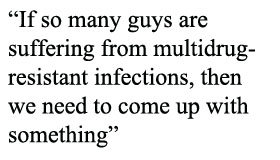The Battle on the Home Front: The Jonathan Gadsden Story
Since Operations Iraqi Freedom and Enduring Freedom began, many American servicemen and women have been infected with antibiotic-resistant bacteria.¹ While our men and women in uniform increasingly survive severe wounds sustained in combat, their injuries leave them susceptible to life-threatening, hard-to-treat infections. Marine Lance Corporal Jonathan Gadsden's story reflects the growing need for new antibiotics that can treat these dangerous diseases, against which most drugs are useless.
Twenty-year-old Marine Lance Corporal Jonathan Gadsden was seriously wounded on August 21, 2004, after a homemade bomb exploded under his Humvee in Anbar Province, Iraq.²
Cpl. Gadsden was treated on the scene by combat medics and then airlifted to a military hospital in a former health care facility in Baghdad. Surgeons repaired wounds to his cranium, removed his spleen, and administered powerful antibiotics to ward off potential infections. Once stable, Cpl. Gadsden was transferred to an American military hospital in Germany and then to the National Naval Medical Center in Maryland, where he tested positive for a variety of pathogens, including Acinetobacter baumannii, Staphylococcus, Pseudomonas, Klebsiella, and Enterobacter — most of which are commonly multidrug-resistant.
 By September, he seemed to be on the road to recovery. Cpl. Gadsden was able to breathe without a ventilator and move about with a walker. When he was transferred to the James A. Haley Veterans' Hospital in Florida, his new doctors told his mother, Zeada Gadsden, that her son might be able to return home to South Carolina by the end of October.
By September, he seemed to be on the road to recovery. Cpl. Gadsden was able to breathe without a ventilator and move about with a walker. When he was transferred to the James A. Haley Veterans' Hospital in Florida, his new doctors told his mother, Zeada Gadsden, that her son might be able to return home to South Carolina by the end of October.
But in early October, after finishing his prescribed course of antibiotics, Cpl. Gadsden began to exhibit symptoms as if an infection was present. When testing showed he had a urinary tract infection, doctors administered more antibiotics. His condition initially improved, but by October 17 he began to deteriorate.
Three days later, he had a seizure and went into cardiac arrest. Even though Cpl. Gadsden was given a number of antibiotics—at least four different classes—they proved insufficient. He died on October 22, 2004.
Cpl. Gadsden's death demonstrates the great and growing threat of infections that are difficult, and sometimes impossible, to treat, complicating the care of our combat-injured military personnel.³
Mrs. Gadsden laments that the doctors ran out of options to treat her son's illness. “If so many guys are suffering from multidrug-resistant infections, then we need to come up with something,” she said.
1. C. K. Murray et al., "Infections complicating the care of combat casualties during operations Iraqi Freedom and Enduring Freedom," Journal of Trauma and Acute Care Surgery 71, no. 1 Suppl (2011).2. J. D. Daigh, "Healthcare Inspection: Review of Quality of Care, Department of Veterans Affairs, James A. Haley Medical Center,Tampa, Florida," ed. Department of Veterans Affairs Office of Inspector General (Washington, DC 2005).3. D. R. Hospenthal et al., "Multidrug-resistant bacterial colonization of combat-injured personnel at admission to medical centers after evacuation from Afghanistan and Iraq," Journal of Trauma a nd Acute Care Surgery 71, no. 1 Suppl (2011).











